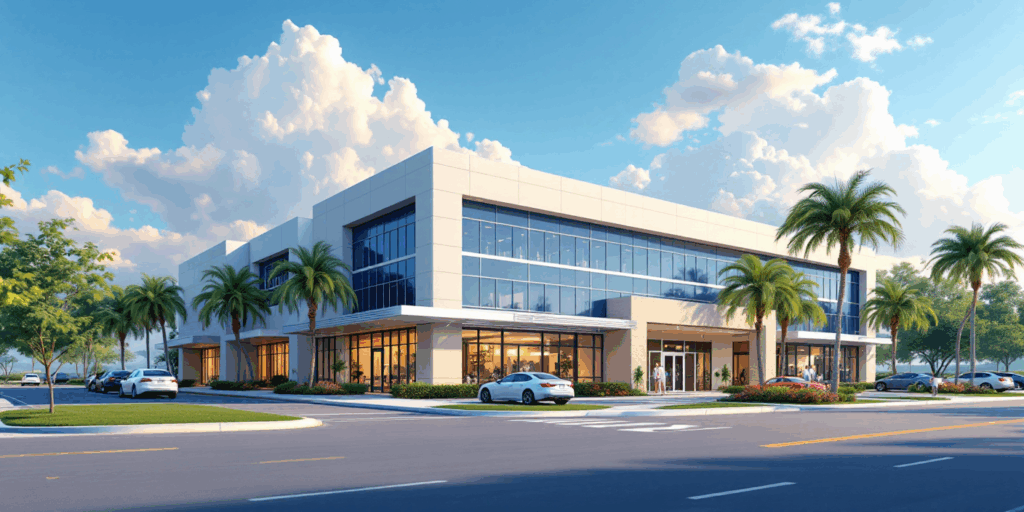Understanding Commercial Real Estate
At its core, what is considered commercial real estate refers to properties used primarily for business purposes rather than residential living. These assets are designed to generate income, either through rental yields or capital appreciation when sold. Unlike homes or apartments meant for personal habitation, CRE encompasses buildings and land intended for commercial activities, such as offices, stores, or warehouses.
The sector plays a pivotal role in shaping business landscapes and investment opportunities in today’s dynamic economy. Whether you’re a budding entrepreneur, an investor, or simply curious about the property market, understanding CRE is essential for navigating modern real estate markets.
Income Generation: Properties leased to tenants provide steady revenue streams
Zoning Regulations: Subject to specific laws dictating usage and compliance
Scale & Complexity: Larger transactions with intricate financing structures
What Makes Property “Commercial”?
Business Purpose
Properties designed and zoned specifically for commercial activities and business operations rather than residential living.
Profit Generation
Assets intended to produce income through rental yields, lease agreements, business income, or capital appreciation upon sale.
Commercial Tenants
Spaces leased to businesses, retailers, or organizations conducting profit-making ventures and commercial services. Usually involves LLCs and Corporations on the lease – not individuals (except for personal guarantees).
Essentially, if the property supports business operations or profit-making ventures, it falls under the commercial real estate category. This distinction is crucial for investors, developers, and business owners alike as they navigate zoning requirements, financing options, and market opportunities.
The Spectrum of Commercial Real Estate Types
One of the most frequently asked questions about commercial real estate concerns its various categories. The CRE sector is remarkably diverse, catering to different industries, investment strategies, and market demands. Understanding these types helps investors target niches based on current trends and economic conditions.
Office Properties
Professional workspaces ranging from downtown high-rises to suburban office parks, medical, etc. Examples include corporate headquarters and co-working spaces like WeWork.
Retail Centers
Properties for selling goods and services directly to consumers, from retail shopping malls to strip centers and standalone restaurants. Retail can encompass many different types of consumer businesses.
Industrial Facilities
Warehouses, factories, and logistics hubs used for manufacturing, storage, and distribution, like fulfillment centers.
Multifamily Housing
Residential buildings with multiple units (CRE are typically 5+), treated as commercial due to their income-generating potential and size.

More Commercial Property Categories
Hospitality Properties
Properties focused on lodging and entertainment, including hotels, resorts, and boutique accommodations. These properties generate revenue through nightly rates and amenity services.
Mixed-Use Developments
Developments combining multiple functions in one space—such as urban buildings with retail on the ground floor and offices or apartments above. These create vibrant, walkable communities.
Special Purpose Properties
Unique properties designed for specific uses, including hospitals, schools, data centers, self-storage facilities, IOS, and specialized institutional buildings.
Land Development
Undeveloped parcels zoned for future commercial development, offering opportunities for ground-up construction and value creation.
More Commercial Property Categories
Hospitality Properties
Properties focused on lodging and entertainment, including hotels, resorts, short-term (vacation VRBO and AirBNB) rental multi-family, and boutique accommodations. These properties generate revenue through nightly rates and amenity services.
Mixed-Use Developments
Developments combining multiple functions in one space, such as urban buildings with retail on the ground floor and offices or apartments above. These create vibrant, walkable communities.
Special Purpose Properties
Unique properties designed for specific uses, including hospitals, schools, data centers, self-storage facilities, IOS (Industrial Outdoor Storage), and specialized institutional buildings.
Land Development
Undeveloped parcels zoned for future commercial development, offering opportunities for ground-up construction and value creation.
Market Trends Shaping CRE Categories
The commercial real estate landscape continuously evolves in response to economic shifts, technological advances, and changing consumer behaviors. Understanding these trends helps investors make informed decisions about which property types offer the strongest growth potential.
E-Commerce Boom
Rise in online shopping has dramatically boosted demand for industrial CRE, particularly warehouses and distribution centers.
Remote Work Impact
Shifting workplace trends have transformed office space dynamics, with increased demand for flexible and hybrid-ready environments.
Urbanization Patterns
Continued urban development drives demand for mixed-use properties that combine living, working, and entertainment spaces.
Commercial vs. Residential Real Estate
A common question contrasts commercial vs residential real estate. While both involve property ownership and management, the key distinctions lie in purpose, operations, and economics. Understanding these differences is crucial for anyone transitioning from home buying to commercial investments.
| Factor | Commercial Real Estate | Residential Real Estate |
| Primary Purpose | Business operations and income generation | Personal living and habitation |
| Lease Terms | Longer leases (3-10+ years) with shared maintenance | Shorter leases (6-12 months), tenant-focused |
| Valuation Method | Based on income potential and cap rates | Driven by comparable sales and location amenities |
| Financing | Higher down payments, underwritten on property income | Lower down payments, based on borrower income |
| Regulations | Complex zoning, environmental, and ADA compliance | Residential building codes and safety standards |
| Risk Profile | Economic downturns affect businesses significantly | More stable, tied to housing market cycles |
Key Advantages of Commercial Investment
Higher Returns
CRE offers potential for greater rental income, ROI, and long term property appreciation compared to residential properties. Commercial tenants often pay higher rents, and lease structures can include annual escalations that boost returns over time.
Portfolio Diversification
Adding commercial properties to your investment portfolio provides stability and reduces exposure to stock market volatility. Real estate often moves independently of equities, offering a hedge against market downturns.
Tax Advantages
Investors benefit from significant tax deductions including depreciation, mortgage interest, operating expenses, and property improvements. These advantages can substantially reduce taxable income and enhance overall returns.
Inflation Hedge
Commercial rents typically rise with inflation through escalation clauses in lease agreements, preserving real value. Property values also tend to appreciate during inflationary periods, protecting purchasing power.
Long-Term Growth
Urbanization and economic expansion continue to drive sustained demand for commercial spaces. Population growth and business development create ongoing opportunities for property appreciation and rental income.
Professional Relationships
Commercial tenants are typically businesses that maintain professional relationships, often resulting in longer lease terms, better property maintenance, and more predictable cash flows than residential tenants.
Investment Considerations & Challenges
While commercial real estate offers compelling advantages, it’s not without significant challenges that require careful consideration. Successful CRE investors understand both the opportunities and the risks inherent in this asset class.

Key Challenges to Consider
- Market Fluctuations: Economic cycles can dramatically impact demand for commercial space and property values
- Tenant Vacancies: Extended vacancy periods can severely impact cash flow and return on investment
- Capital Requirements: Higher upfront costs and larger down payments compared to residential properties
- Management Complexity: Professional property management often required, adding to operational costs
- Market Knowledge: Requires deeper understanding of local markets, tenant industries, and economic trends
Advanced tools and platforms can help analyze trends, forecast opportunities, and mitigate these risks through data-driven decision making.
Getting Started in Commercial Real Estate
If you’re wondering how to enter the commercial real estate market, the key is starting with thorough education and strategic research. Success in CRE requires careful planning, market knowledge, and often professional guidance to navigate the complexities of commercial property transactions.
Define Your Investment Goals
Clarify whether you’re interested in buying property directly, leasing commercial space for your business, or investing passively through REITs (Real Estate Investment Trusts). Each path requires different capital, expertise, and involvement levels.
Build Market Knowledge
Study local market conditions, property types, and economic trends affecting commercial real estate. Understanding supply and demand dynamics in your target market is crucial for making informed investment decisions.
Assemble Your Team
Partner with experienced professionals including commercial real estate brokers, attorneys, accountants, and property managers. Their expertise in due diligence, financing, and operations is invaluable for successful transactions.
Secure Financing
Explore commercial loan options, understanding that lenders typically require larger down payments (20-30%) and evaluate deals based on property income potential rather than personal income alone. The SBA Website offers lots of guidance.
Conduct Due Diligence
Perform thorough property inspections, financial analysis, tenant reviews, and market comparisons. This critical step helps identify potential issues and validates investment assumptions before closing.
Your Next Steps in Commercial Real Estate
Stay Informed
Commercial real estate is dynamic and constantly evolving. Keep up with market trends, economic indicators, and industry news to identify emerging opportunities and potential challenges in your target markets. Having a trusted CRE agent by your side can help!
Start Small, Think Big
Consider beginning with smaller investments or REIT stock exposure to gain experience before committing significant capital. Many successful CRE investors started with modest properties and scaled up over time.
Network Actively
Build relationships with brokers, investors, lenders, and property managers. The commercial real estate community values connections, and many opportunities arise through professional networks and referrals.
TL;DR – Commercial real estate is a vast, opportunity-rich field that extends far beyond simple property ownership, it’s about fueling businesses, creating communities, and driving economic growth. Whether you’re leasing office space, investing in a warehouse, or exploring mixed-use developments, knowledge forms the foundation of success.
By understanding the fundamentals covered in this basic guide; from property types and valuation methods to investment strategies and market trends… you’re better equipped to navigate the CRE landscape with confidence. CRE offers compelling opportunities for those willing to invest time in education and careful analysis. Interested in more information or a consult? Contact me today – Eric
GET IN TOUCH

